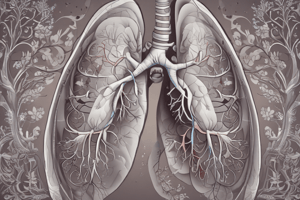Podcast
Questions and Answers
What is the main characteristic of Obstructive Lung Disease?
What is the main characteristic of Obstructive Lung Disease?
- Stiff or fibrotic lungs
- Airway obstruction, making it difficult to breathe out (correct)
- Infection of lung tissue, causing inflammation and scarring
- Uncontrolled growth of abnormal cells in the lungs
What is Pulmonary Fibrosis?
What is Pulmonary Fibrosis?
- A fungal infection of the lungs
- A type of pneumonia
- Scarring of lung tissue, reducing lung expansion (correct)
- A type of lung cancer
What is the main characteristic of Restrictive Lung Disease?
What is the main characteristic of Restrictive Lung Disease?
- Infection of lung tissue, causing inflammation and scarring
- Stiff or fibrotic lungs, making it difficult to breathe in (correct)
- Airway obstruction, making it difficult to breathe out
- Uncontrolled growth of abnormal cells in the lungs
What is Pneumonia?
What is Pneumonia?
What is Cystic Fibrosis?
What is Cystic Fibrosis?
What is Pulmonary Embolism?
What is Pulmonary Embolism?
Flashcards are hidden until you start studying
Study Notes
Obstructive Lung Disease
- Characterized by airway obstruction, making it difficult to breathe out
- Types:
- Chronic Obstructive Pulmonary Disease (COPD)
- Emphysema: damage to alveoli, reducing gas exchange
- Chronic Bronchitis: inflammation and narrowing of bronchi
Restrictive Lung Disease
- Characterized by stiff or fibrotic lungs, making it difficult to breathe in
- Types:
- Pulmonary Fibrosis: scarring of lung tissue, reducing lung expansion
- Sarcoidosis: inflammation and scarring of lung tissue
- Pneumonia: infection of lung tissue, causing inflammation and scarring
Infections
- Pneumonia: infection of lung tissue, causing inflammation and consolidation
- Tuberculosis (TB): bacterial infection of the lungs, causing granulomas and cavitation
- Fungal infections: e.g., Aspergillosis, Candidiasis
Neoplasms
- Lung Cancer: uncontrolled growth of abnormal cells in the lungs
- Types: Adenocarcinoma, Squamous Cell Carcinoma, Large Cell Carcinoma
- Metastatic Cancer: cancer that spreads to the lungs from other parts of the body
Vascular Diseases
- Pulmonary Embolism: blockage of pulmonary arteries, reducing blood flow
- Pulmonary Hypertension: high blood pressure in the pulmonary arteries
Other Conditions
- Cystic Fibrosis: genetic disorder affecting mucus production, leading to respiratory and digestive problems
- Pleural Effusion: accumulation of fluid between the lungs and chest wall
- Pneumothorax: collapse of the lung due to air in the pleural space
Obstructive Lung Disease
- Characterized by airway obstruction, making it difficult to breathe out
- COPD is a progressive lung disease that makes it hard to breathe
- Emphysema damages alveoli, reducing gas exchange and making it hard to breathe
- Chronic Bronchitis causes inflammation and narrowing of bronchi, leading to breathing difficulties
Restrictive Lung Disease
- Characterized by stiff or fibrotic lungs, making it difficult to breathe in
- Pulmonary Fibrosis causes scarring of lung tissue, reducing lung expansion and making it hard to breathe
- Sarcoidosis leads to inflammation and scarring of lung tissue, making breathing difficult
- Pneumonia causes inflammation and scarring of lung tissue, leading to breathing difficulties
Infections
- Pneumonia is an infection of lung tissue, causing inflammation and consolidation
- Tuberculosis (TB) is a bacterial infection of the lungs, causing granulomas and cavitation
- Fungal infections, such as Aspergillosis and Candidiasis, can affect the lungs
Neoplasms
- Lung Cancer is uncontrolled growth of abnormal cells in the lungs
- Adenocarcinoma is a type of lung cancer that originates in the glands
- Squamous Cell Carcinoma is a type of lung cancer that originates in the lining of the bronchi
- Large Cell Carcinoma is a type of lung cancer that grows and spreads quickly
- Metastatic Cancer is cancer that spreads to the lungs from other parts of the body
Vascular Diseases
- Pulmonary Embolism is a blockage of pulmonary arteries, reducing blood flow to the lungs
- Pulmonary Hypertension is high blood pressure in the pulmonary arteries, making it hard for the heart to pump blood
Other Conditions
- Cystic Fibrosis is a genetic disorder affecting mucus production, leading to respiratory and digestive problems
- Pleural Effusion is an accumulation of fluid between the lungs and chest wall, causing breathing difficulties
- Pneumothorax is the collapse of the lung due to air in the pleural space, making it hard to breathe
Studying That Suits You
Use AI to generate personalized quizzes and flashcards to suit your learning preferences.




